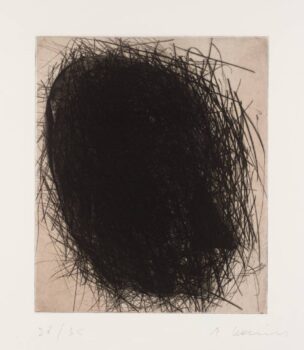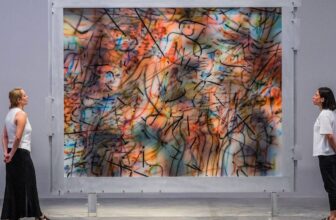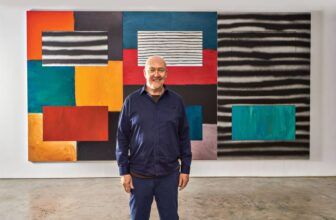Arnulf Rainer Famous Paintings
Arnulf Rainer is a name that echoes far beyond the borders of Austria, reaching deep into the veins of contemporary art history. His career spans decades, and his contributions to abstract expressionism and art informel have made him an enduring figure in the modern art world. Known for his intense and often confrontational approach to painting, Rainer did not simply create works of art, he challenged the very idea of what art could be.
This story dives into the man, his methods, the works that made him famous, the materials he used, the locations where his masterpieces reside, and the ever-growing value of his oeuvre.
The Man Behind the Paintbrush
Arnulf Rainer was born on December 8, 1929, in Baden, near Vienna, Austria. Growing up during the politically turbulent years before and after World War II, Rainer’s early life was marked by instability, which in turn fueled his artistic rebellion. He briefly attended the Academy of Fine Arts in Vienna but left without completing his studies, frustrated by the constraints of academic training.
From the very beginning, Rainer showed signs of rejecting conventional beauty and embracing intensity, chaos, and raw emotional expression. His work often involved pushing materials and techniques to extremes, creating pieces that vibrated with energy.
What Arnulf Rainer Was Known For
Arnulf Rainer’s fame stems largely from his overpainting technique. In the mid-1950s, he began to take existing images, often photographs or earlier paintings, and paint over them, obscuring, transforming, or entirely annihilating the original work beneath. This process was not an act of destruction for its own sake; it was a dialogue between the past and present, between creation and obliteration.
He was also known for:
Intense self-portraits: Many of his works involved photographs of himself that he would heavily alter or deface with paint, creating grotesque, visceral images of distorted facial expressions.
Spiritual and existential themes: Religious iconography, death, and transcendence frequently surfaced in his art.
Art Informel influence: He embraced gestural abstraction, often linked to the European counterpart of abstract expressionism.
Experimentation: Rainer’s refusal to be tied to one style or medium allowed him to explore photography, drawing, printmaking, and mixed media.
His art was both deeply personal and provocatively public, an intersection of psychological exploration and avant-garde rebellion.
Famous Paintings by Arnulf Rainer
Arnulf Rainer’s career spans thousands of works, several paintings stand out as iconic representations of his style and vision:
Face Farces (1969–1975) – A series of overpainted self-portraits where Rainer contorted his face into extreme expressions, then enhanced the grotesquerie with thick, chaotic strokes of paint. These works challenged traditional notions of portraiture and beauty.
Death Masks (1970s) – Overpaintings applied to photographs of death masks, merging the stillness of death with the violence of the brushstroke. These works explore mortality and the fragility of identity.
Cross Paintings (1950s–1960s) – Rainer’s fascination with religious symbolism is evident in these abstract works that incorporate the shape of the cross. The crosses are often obscured, layered, or blurred, reflecting the complexity of faith and spirituality.
Veiled Landscapes – These paintings often began as photographs or realistic landscapes, which he would partially or entirely cover with layers of paint, transforming them into meditations on absence and memory.
Overpainted Photographs of Hiroshima and Nagasaki Victims – Perhaps among his most emotionally charged works, these pieces blend documentary images with abstract, emotional interventions in paint, confronting viewers with the horrors of human destruction.
How Arnulf Rainer Made His Paintings
Rainer’s approach to painting was anything but conventional. His overpainting process began with an existing surface, this could be one of his own earlier works, a found photograph, or a historical image. Then, he would attack the surface with brush, fingers, or other tools, layering paint until the original image was partially or completely transformed.
His methods included:
Physicality: He often painted in a frenzy, allowing the movement of his body to dictate the flow of lines and shapes.
Layering: Rainer’s works often have multiple layers of paint, each responding to and interacting with what lies beneath.
Nontraditional tools: Beyond brushes, he sometimes used his hands, cloths, or even scraping instruments to manipulate paint.
Color psychology: Although he frequently used black and dark tones to create drama and intensity, he also employed striking reds, yellows, and whites to evoke emotion.
Rainer himself described the act of painting as a confrontation, both with the subject matter and with the medium itself.
How Many Paintings Arnulf Rainer Has
Estimating the exact number of paintings by Arnulf Rainer is challenging. Over a career spanning more than seven decades, he produced thousands of works, including oil paintings, mixed media pieces, drawings, and overpainted photographs. Many are held in private collections, while others belong to major institutions. His prolific output reflects a restless creative energy that never allowed him to linger too long in any one style.
What Art Style Arnulf Rainer Is Associated With
Arnulf Rainer is most closely associated with:
Art Informel – The European post-war movement characterized by abstract forms, gestural brushwork, and emotional spontaneity.
Abstract Expressionism – Especially the European interpretation, where personal emotion and subconscious imagery dominate the composition.
Overpainting – A signature style so deeply tied to Rainer that it is impossible to separate the man from the method.
Action Painting – His vigorous application of paint and gestural energy align with the principles of action painting.
His style bridges abstraction and figurative work, often oscillating between the two within the same piece.
Materials Arnulf Rainer Uses
Rainer’s material palette was as varied as his styles. He used:
Oil paints – For their richness and texture.
Acrylic paints – Offering quick-drying flexibility for layering.
Photographic prints – Serving as the base for his overpaintings.
Graphite, charcoal, and ink – For sketching or integrating into mixed media works.
Canvas, wood, and paper – His supports ranged from traditional stretched canvas to unconventional materials.
Found images – Including postcards, historical photographs, and religious prints.
His use of materials was always in service of his conceptual aims, not bound by tradition.
Where Arnulf Rainer’s Paintings Are Located
Rainer’s work resides in museums, galleries, and private collections worldwide. Some notable locations include:
Arnulf Rainer Museum in Baden, Austria – Dedicated entirely to his life and work, housing a vast selection of his paintings, drawings, and photographs.
Museum of Modern Art (MoMA) in New York – Holds selected works in its permanent collection.
Albertina Museum in Vienna – Features his works alongside other Austrian and European masters.
Centre Pompidou in Paris – Recognized for its modern art collection, which includes Rainer.
Tate Modern in London – Has exhibited his works in the context of post-war European art.
In addition, numerous galleries across Europe, North America, and Asia represent his work, and private collectors prize his paintings for both their artistic and investment value.
How Much Arnulf Rainer’s Paintings Cost
Arnulf Rainer’s paintings vary widely in price depending on size, medium, and provenance. Smaller works on paper can sell for tens of thousands of dollars, while large, historically significant paintings have reached several hundred thousand dollars at auction.
For example:
Small overpainted photographs may range from $20,000 to $50,000.
Large-scale oil overpaintings, especially from the 1950s–1970s, can fetch $200,000–$500,000 or more.
Rare, museum-quality works occasionally exceed $1 million, particularly if tied to landmark series such as the Cross Paintings or Face Farces.
The art market values Rainer not only for his historical significance but also for the rarity of his early, seminal works.
The Evolution of Rainer’s Career
Rainer’s early works in the 1950s leaned toward surrealism and abstract landscapes before he fully embraced overpainting. By the 1960s, he was internationally recognized, participating in exhibitions across Europe and the United States.
His art evolved alongside global cultural shifts, during the Vietnam War era, his works took on a darker, more confrontational tone; in later years, he explored themes of aging and mortality. Despite changing themes, his intensity remained constant.
Rainer’s Philosophy of Art
Arnulf Rainer’s artistic philosophy rejected neat categories and tidy resolutions. He saw painting as an act of wrestling with existence, layer by layer, gesture by gesture. His overpaintings can be read as both erasure and revelation: while he obscures what was there before, he also creates something new, breathing fresh life into the old.
In his own reflections, Rainer suggested that covering an image was a way of getting closer to it, of merging with it. The act of painting over a face or a scene was not a denial, but an embrace.
Arnulf Rainer Legacy and Influence
Rainer’s influence extends far beyond Austria. Contemporary artists who work with appropriation, transformation, and layered imagery owe part of their vocabulary to his experiments. His willingness to confront uncomfortable subjects, death, religious doubt, personal vulnerability, set a precedent for raw honesty in modern art.
Today, the Arnulf Rainer Museum continues to introduce new generations to his work, hosting retrospectives, thematic exhibitions, and dialogues between Rainer and other contemporary artists.
Conclusion: The Enduring Power of Arnulf Rainer
Arnulf Rainer’s paintings are not polite. They demand attention, provoke thought, and refuse to be ignored. Whether a massive oil overpainting or a small altered photograph, each piece contains the same restless spirit, a refusal to leave the world as it is.
His works are scattered across the globe, in museums, galleries, and private homes, but all share a common thread: they bear the mark of an artist who saw painting as an existential act. Rainer’s career, spanning over seventy years, shows no sign of fading in relevance.
For collectors, his works are both treasured possessions and appreciating assets. For art lovers, they are windows into the mind of a man who painted not only with color and brush, but with the full force of his being.
Arnulf Rainer’s legacy will continue to grow, as future audiences discover that beneath the thick layers of paint lies not destruction, but the pure, unfiltered pulse of creation itself.




